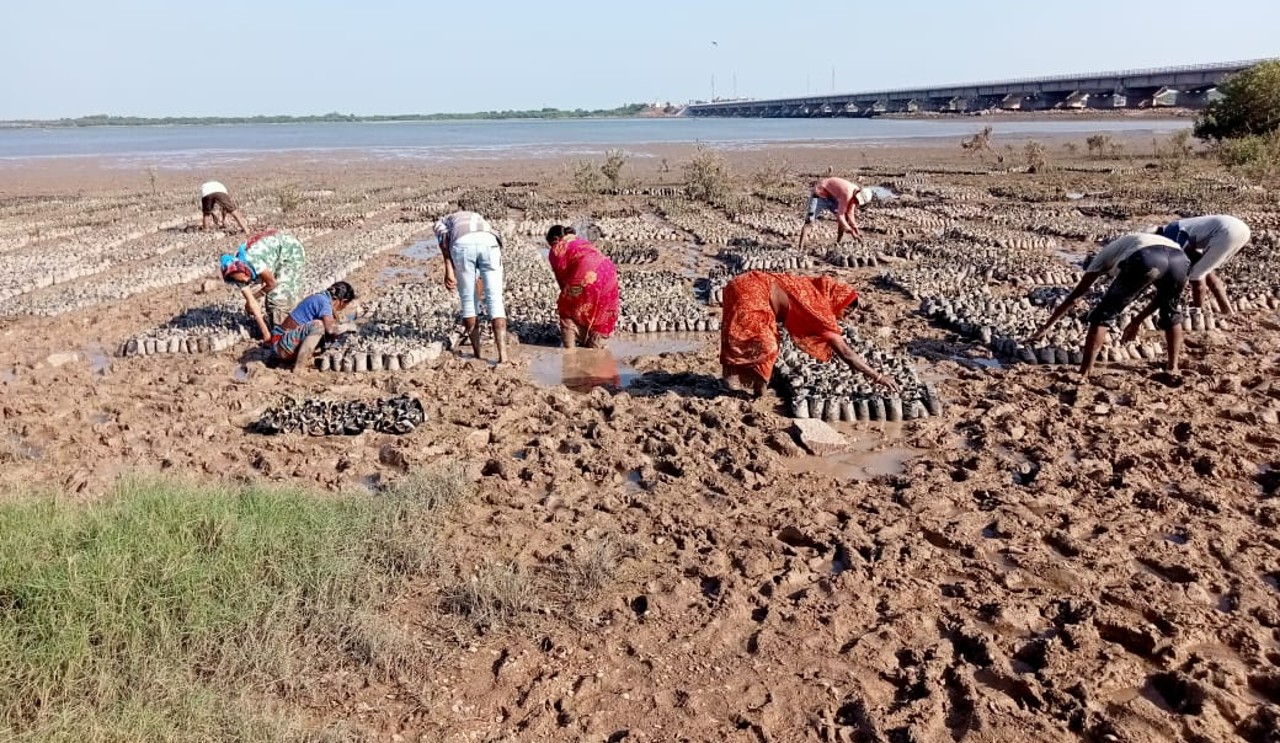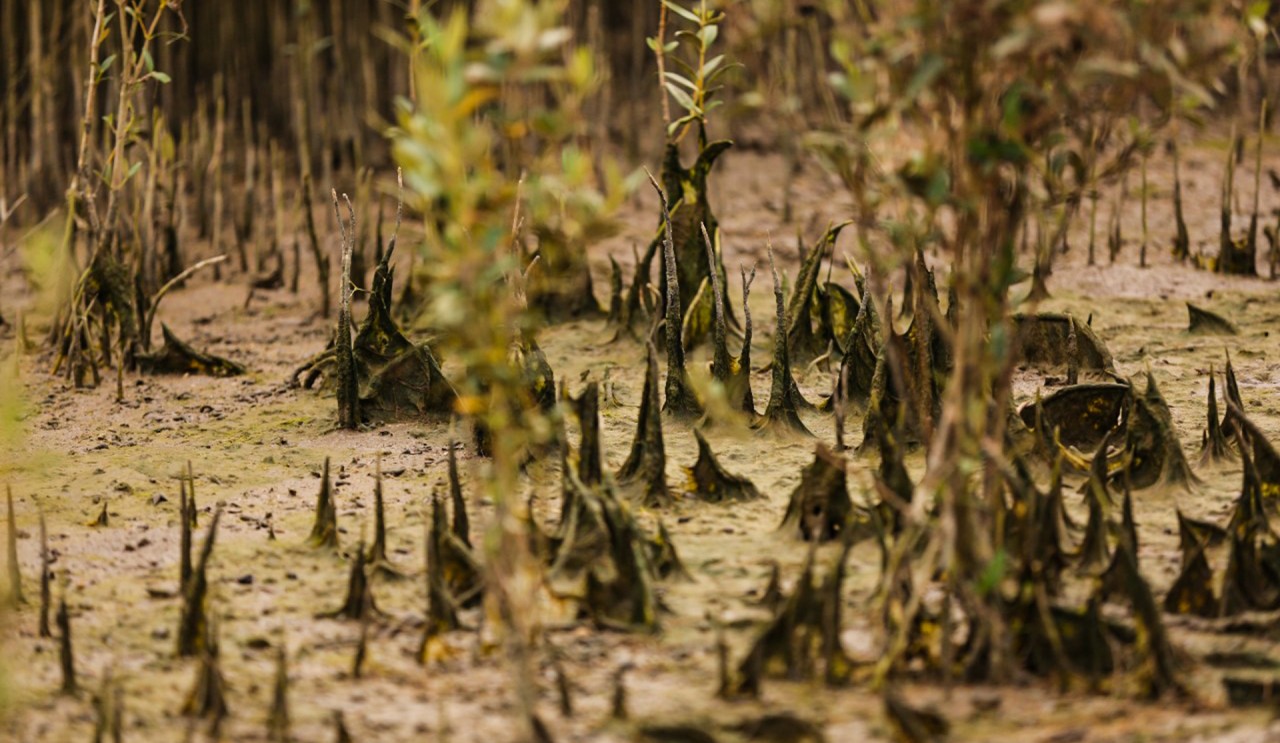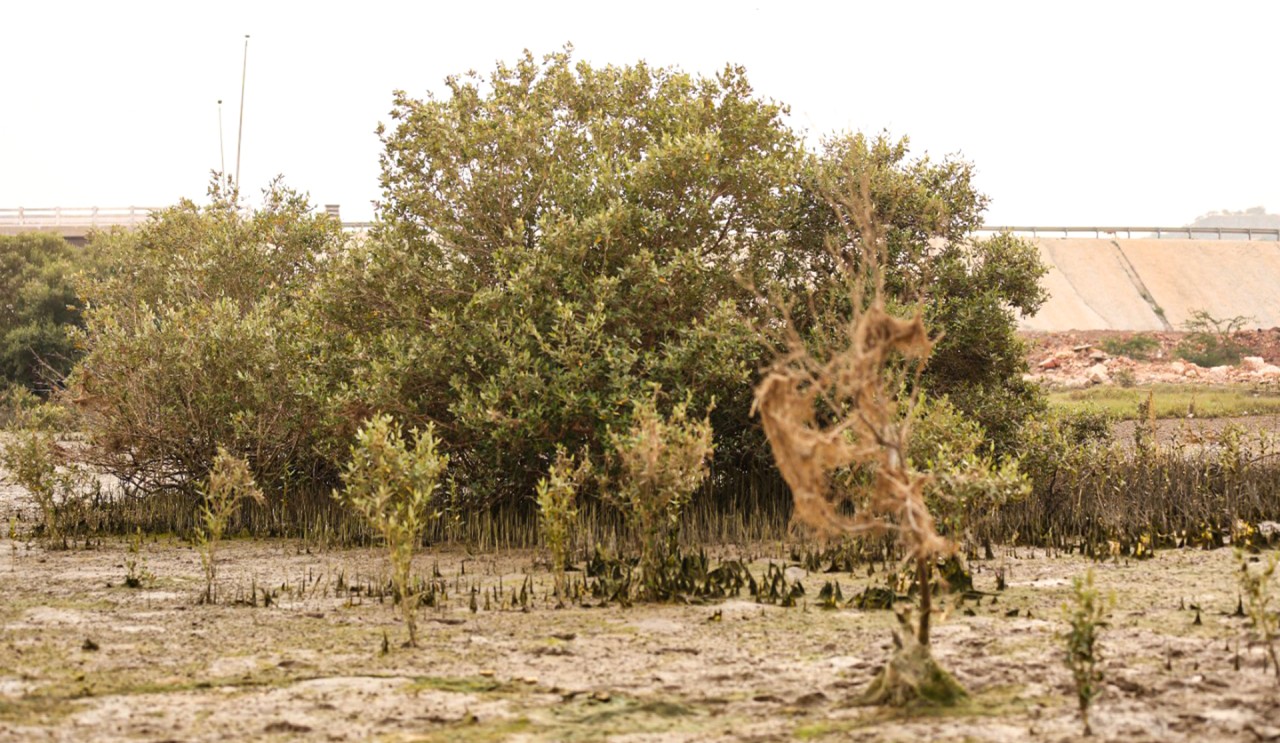Regenerating mangrove ecosystem through income enhancement of landless women
General Background
Mangrove forests are highly productive coastal ecosystems that support many species of flora and fauna (Bhomia et al., 2016). Mangrove ecosystems offer a multitude of goods and services making them ecologically and economically important (Rahman et al., 2021). These benefits include climate regulation, shoreline stabilization, storm protection, flood control, sediment and nutrient retention, biodiversity conservation and habitat protection, tourism and recreation, fishing, forestry products, and alternative livelihoods to the local community (Rahman et al., 2021; Ahmed et al., 2017; Estrada and Soares, 2017; Feller et al., 2017; Bhomia et al., 2016). Worldwide, local rural communities living around the mangrove areas, particularly landless labourers, heavily depend on mangrove products directly and indirectly to generate their subsistence and income (Aye et al., 2019). However, one of the threats to mangrove conservation is utilizing mangrove ecosystems for economic purposes without considering ecological aspects and low public awareness (Garsetiasih et al., 2021).
They safeguard the ecological security of the coastal belt while sequestering and storing atmospheric carbon (Estrada and Soares, 2017). Worldwide, blue carbon ecosystems, like seagrass, mangroves, and salt marshes, sequester and store more carbon per unit area than terrestrial forests (Ahmed et al., 2017; Estrada and Soares, 2017). Globally, they store about 11.5 billion tonnes of carbon, of which mangroves have the highest blue carbon pool (6.5 billion tonnes) despite covering only 27% of the blue carbon ecosystems area (Ahmed et al., 2017). The role of mangrove forests in carbon sequestration makes their restoration and protection a cost-effective Nature-based Solution (NbS) for reducing atmospheric carbon dioxide (Rahman et al., 2021). However, tropical mangrove forests are considered one of the most threatened ecosystems across the tropics and are highly sensitive to environmental change. They are vulnerable to climate change stressors, such as the sea-level rise and drought, and to anthropogenic impacts, like conversion to aquaculture and agriculture, urbanization, and pollution (Singh, 2020; Feller et al., 2017; UNEP, 2014). To combat this, there is an immediate need for sustainable coastal protection measures.
This case study describes how women self-help group (SHG) members, largely from landless families, from a small coastal village in the western region of the state of Gujarat in India, are leading a successful coastal restoration and protection endeavour. The mangrove plantation activity is planned and implemented by Aga Khan Rural Support Programme – India (AKRSP-I) under the Low-Carbon Agriculture Pathways project with external funding from Children’s Investment Fund Foundation (CIFF), and technical know-how from Saline Area Vitalization Enterprise Limited (SAVE). The activity is planned with a predominant aim to sequester and store atmospheric carbon and provide sustainable livelihoods to the local community while empowering women.
Socio-economic livelihood profile of the local community, history, and status of mangroves in the area
The State of Gujarat has the second largest mangrove cover in India, i.e., 23% of the total mangrove cover, which has increased from 427 km2 in 1987 to 1175 km2 in 2021, the majority of which falls under the ‘open mangrove’ category (FSI, 2021). However, there is less species diversity in Gujarat compared to other mangrove habitats in the country (Ragavan et al., 2016). There are 15 mangrove species belonging to 10 genera and 6 families, which occur naturally in the Indus deltaic region of Kachchh (Kori creek and Sir Creek), Gulf of Kachchh, Gulf of Khambhat, and South Gujarat (Ragavan et al., 2016). Avicennia marina, also known as gray or white mangrove, is the most abundant and dominant mangrove species with natural geographic distribution throughout the State. However, it is found sparsely in the region mainly due to anthropogenic activities like deforestation, soil and water pollution, and resulting habitat degradation (Singh, 2020). Rhizophora apiculate, a commonly distributed mangrove species in other parts of India, has not been recorded for more than one decade in Gujarat (Pandey and Pandey, 2011). Bhatt et al., (2009) reported the occurrence of seven mangrove species in Purna estuary, South Gujarat, which makes it one of the most diverse mangrove patches in the State.
The intervention
The coastal restoration and protection activity through the plantation of Avicennia marina mangrove was initiated in the year 2021 by AKRSP(I) in Gandhavi village in Kalyanpur block of Devbhumi Dwarka district in western Gujarat, India. Establishing the fact that the plantation of mangroves is in the interest of both the community as well as the environment does not solve anything, but the crusade begins from there. Restoration, management, or protection of mangrove ecosystems cannot be achieved without the active support and participation of the local community and community-based institutions (Febryano, et al., 2014). At the same time, due administrative procedures also needed to be followed for the planned activities. AKRSP(I) has adopted a participatory approach and started engaging with the local community. The process followed for mangrove plantation is given below:
- Site selection, evaluation, and monitoring:
- A potential site for a mangrove plantation was identified, which was evaluated with respect to its natural and socio-economic suitability along with enabling conditions, including, understanding geographical status, vegetation occurrence, natural stresses and anthropogenic disturbances, and soil and water testing, etc.
- The selected plantation site met both natural and socio-economic suitability, as the site is on a tidal mudflat with signs of mangrove vegetation and the majority of the community and its leaders support mangrove plantation in the proposed site.
- A basic survey of mangrove species occurring on and near the plantation site was also performed. It was identified that Avicennia marina occurs naturally at our plantation site.
- The frequency and duration of all tides at the plantation site were monitored daily, where the duration for which the plantation site remained submerged underwater and how long it remained dry were recorded.
- The AKRSP(I) team then engaged with the forest department and the District Collector of Devbhumi Dwarka. After several months of persistent efforts by the team, a ‘No Objection Certificate’ was received for plantation in 33-hectares land.
- Creating awareness among the local community women and men:
- Parallelly, the project implementation team conducted several awareness generation meetings with the local community, which included the Sarpanch (head of the village council), local men, women leaders, and different women SHGs.
- In these meetings, the local community was asked about the mangroves that previously grew on the site, which was then matched with the information gathered from the species occurrence survey.
- Gramya Vikas Trust, a local non-governmental organisation, connected us with women’s SHGs. More than 30 women from three different SHGs were identified, who were willing to participate in the mangrove plantation and management activities. These women are mostly landless farmers with livestock.
- Capacity building of the field staff and women SHGs:
- Women have always been at the forefront of every activity undertaken by AKRSP(I).
- The local field staff and SHG women were provided with skill development training and capacity building for mangrove plantation, restoration, protection, and management by SAVE.
- Several skill development training and capacity building programmes were organised in the form of meetings, demonstrations, and exposure visits.
- Development and protection of nursery by SHG women:
- During the fruiting season, after much hardship, about 71,000 mangrove seeds and 7,000 propagules were procured by AKRSP(I) and SAVE field teams from the nearby coastal areas of Devbhumi Dwarka and Porbandar districts to prepare a nursery, where approx. 78,000 mangrove seedlings were developed.
- SHG women worked daily in shifts to manage the mangrove nursery and played a vital role in the management and protection of the nursery over a period of 4-5 months. The initial three months proved to be crucial and extremely laborious.
- Fencing was done around the nursery to protect seedlings from livestock and camels.
- Removal of algae and unwanted vegetation — mangrove seedlings used to get covered with algae, after every large tide, which required immediate manual removal to protect seedlings from dying. Women also removed any unwanted vegetation from the nursery at least once a week.
- Removal of insects and pests — women conducted regular inspections for insects and pests and manually removed them to protect seedlings.
- With their collaborative and unprecedented efforts, the team and the women successfully raised all seedlings in the nursery with a survival rate of more than 80%.
- Figure 2: SHG women working in the mangrove nursery


- Mangrove plantation:
- Over a period of 4-5 months in the nursery, mangrove seedlings were allowed to attain a height of 40-50 cm before transplantation at the site.
- The plantation site was cleared of unwanted vegetation and rubbish before transplantation.
- Nursery-raised saplings were transplanted as individual plants in the open intertidal mudflats during low tide. To minimize the loss of saplings from drying out, the duration of the incoming tide to cover the site was estimated.
- All saplings were transplanted within a couple of weeks’ time so that they would begin to grow naturally.
- During the first phase, mangrove plantation is carried out in 20-hectares land by SHG women.
- Figure 1: Avicennia marina mangrove in the site

.jpg)

Observed Results and Estimated Long-term Impacts
It is hoped that this participatory mangrove restoration and plantation model will be replicated across the entire coastal belt of Gujarat and that it will become widely adopted as an NbS to address climate change (both mitigation and adaptation) as well as provide biodiversity benefits and human well-being. Few of the observed results and expected long-term impacts of mangrove restoration and plantation activities are given below.
Alternate livelihoods options and Economic development: The mangrove plantation activity did generate an additional source of income for these SHG women. On average, they received Rs. 350 per day (Rs. 1 per sapling planted) as wages for their contribution towards nursery development, management, and mangrove plantation. Several women have bought livestock from their earnings. These women believe that in the coming years, the mangrove trees would likely provide fodder for their livestock and fuelwood for their households.
Climate change mitigation potential (blue carbon):Mangrove forests could capture five times more GHGs than tropical rainforests making them the most carbon-rich forests in the tropics. Avicennia marina has a maturity time of around 3-4 years. In a long term, it has a carbon sequestration potential of approx. 200 megagrams of carbon dioxide equivalent (Mg CO2e) per hectare (Al-Nadabi and Sulaiman, 2018). Considering the initial area under mangrove plantation (i.e., ≈20-hectares) under the restoration project, approx. 4000 Mg CO2e is estimated to be sequestered and stored in a long term, with a potential of an additional 2600 Mg CO2e when all 33-hectares of land will be covered under mangrove forest.
Coastal protection:The mangrove forests also provide non-market ecosystem service in terms of coastal protection (Owuor, et al. 2019). Mangrove forests protect both the saltwater and the freshwater ecosystems they straddle. The mangroves' complex root systems filter nitrates and phosphates that rivers and streams carry to the sea. They would also keep seawater from encroaching on inland waterways. The thickets of mangrove trees would strengthen tidal mudflats and provide a buffer zone to protect the land from wind and wave damage (Athikalam and Vaideeswaran, 2022).
Coastal biodiversity conservation:Another non-market ecosystem service that mangrove forests provide includes biodiversity richness and abundance in terms of creating potential habitat for diverse fauna; breeding/spawning grounds for many local fish, crabs, shrimps, shellfish, and insects; and resting and nesting sites for hundreds of shorebirds and migratory birds, including kingfishers, herons, egrets, etc. (Owuor, et al., 2019). This biodiversity richness and abundance can influence ecosystem processes, functioning, and services (Carugati, et al., 2018).
The way forward:The remaining 13-hectares of land will be covered in the second phase of the plantation. Increase diversity by planting mangrove species other than Avicennia marina and additional terrestrial plants, which could increase biodiversity and ecosystem resilience. Could include more livelihood generation options for the local community.
One way to promote an interest could be ensuring long-term involvement of the local community in mangrove plantation projects, and ensuring short-term incentives in conserving plantations, if villagers have a sense of ownership, mangroves can be conserved better. It’s not too late, we can still protect our remaining mangrove forests and reclaim land for more.
References
- Ahmed, N., Thompson, S., Glaser, M. (2017). Integrated mangrove-shrimp cultivation: Potential for blue carbon sequestration. Ambio, 47:441–452. https://doi.org/10.1007/s13280-017-0946-2.
- Al-Nadabi, A., and Sulaiman, H. (2018). Carbon Sink Potential of Avicennia marina in the Al-Qurm Nature Reserve, Muscat, Oman. IOP Conference Series: Earth and Environmental Science, 151:012003.
- Athikalam, P.T., and Vaideeswaran, A.K. (2022). Vegetation bioshield for coastal protection in South Asia: Status and way forward. Journal of Coastal Conservation, 26(3). https://doi.org/10.1007/s11852-022-00850-x.
- Bhomia, R., Mackenzie, R., Murdiyarso, D., Sasmito, S., et al. (2016). Impacts of Land Use on Indian Mangrove Forest Carbon Stocks: Implications for Conservation and Management. Ecological Applications, 26(5):1396–1408.
- Carugati, L., Gatto, B., Rastelli, E., et al. (2018). Impact of mangrove forests degradation on biodiversity and ecosystem functioning. Scientific Reports, 8:13298. https://doi.org/10.1038/s41598-018-31683-0.
- Estrada, G.C.D., and Soares, M.L.G. (2017). Global patterns of aboveground carbon stock and sequestration in mangroves. Annals of the Brazilian Academy of Sciences, 89(2):973–989. http://dx.doi.org/10.1590/0001-3765201720160357.
- Febryano, I.G., Suharjito, D., Darusman, D., et al. (2014). The Roles and Sustainability of Local Institutions of Mangrove Management in Pahawang Island. Jurnal Manajemen Hutan Tropika (JMHT), 20(2):69–76.
- Feller, I.C., Friess, D.A., Krauss, K.W., Lewis, R.R. (2017). The state of the world’s mangroves in the 21st century under climate change. Hydrobiologia. https://doi.org/10.1007/s10750-017-3331-z.
- Owuor, M.A., Mulwa, R., Otieno, P., et al. (2019). Valuing mangrove biodiversity and ecosystem services: A deliberative choice experiment in Mida Creek, Kenya. Ecosystem Services, 40:101040.
- Rahman, M.M., Zimmer, M., Ahmed, I., et al. (2021). Co-benefits of protecting mangroves for biodiversity conservation and carbon storage. Nature Communications, 12(3875). https://doi.org/10.1038/s41467-021-24207-4.
- Singh, J.K. (2020). Structural characteristics of mangrove forest in different coastal habitats of Gulf of Khambhat arid region of Gujarat, west coast of India. Heliyon, 6:e04685. https://doi.org/10.1016/j.heliyon.2020.e04685.
- UNEP. (2014). The Importance of Mangroves to People: A Call to Action. United Nations Environment Programme.